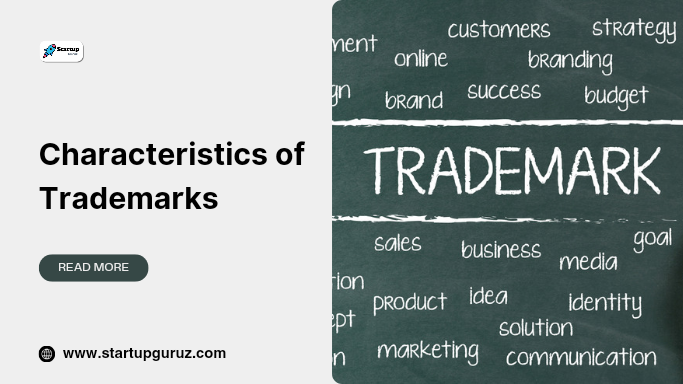Characteristics of Trademark
Characteristics of Trademarks: Ensuring Brand Distinctiveness and Legal Protection
In the vast marketplace, trademarks serve as crucial assets for businesses, embodying brand identity and safeguarding against infringement. Understanding the fundamental characteristics of trademarks is essential for entrepreneurs and companies aiming to establish a unique market presence while adhering to legal requirements. This comprehensive guide explores the key characteristics of trademarks, providing valuable insights and addressing common queries.

1. Distinctiveness:
Trademarks must possess distinctiveness, setting them apart from generic or descriptive terms commonly used in the relevant industry. Distinctive marks are more likely to receive legal protection and effectively represent the brand in the market.
2. Non-Functionality:
Trademarks should not serve a functional purpose beyond distinguishing the goods or services of one entity from another. Functionality may hinder trademark registration and enforcement.
3. Memorability:
Memorable trademarks are easily recalled by consumers, contributing to brand recognition and loyalty. Creative and unique marks tend to be more memorable, facilitating brand visibility and recall.
4. Descriptiveness:
Descriptive marks directly describe the goods or services offered, making them less distinctive and challenging to protect. Trademarks with suggestive, arbitrary, or fanciful elements are generally preferred for stronger legal protection.
5. Durability:
A trademark’s durability refers to its ability to withstand the test of time and remain relevant amidst evolving market trends. Timeless and adaptable marks ensure long-term brand recognition and value.
6. Universality:
Trademarks with universal appeal transcend geographic and cultural boundaries, enabling businesses to expand their presence globally. Universal marks resonate with diverse audiences, fostering brand consistency and acceptance worldwide.
7. Legality:
Trademarks must comply with legal standards and regulations governing intellectual property rights. Unlawful or infringing marks may face legal challenges, resulting in costly litigation and reputational damage.
8. Adaptability:
In today’s dynamic business landscape, trademarks should be adaptable to accommodate changing market dynamics and consumer preferences. Agile marks allow businesses to pivot and innovate while maintaining brand continuity.
9. Brand Alignment:
Effective trademarks align with the brand’s values, messaging, and overall identity, reinforcing brand positioning and differentiation. Consistency between the trademark and brand enhances consumer trust and loyalty.
10. Protection:
Trademarks offer legal protection against unauthorized use or imitation, safeguarding the brand’s reputation and market share. Registered trademarks enjoy exclusive rights, empowering businesses to take legal action against infringers.
Frequently Asked Questions (FAQs) About Trademarks:
Q1: What is the significance of trademark registration?
A: Trademark registration grants exclusive rights to use the mark in connection with specific goods or services, enhancing brand protection and preventing unauthorized use by competitors.
Q2: Can descriptive terms be registered as trademarks?
A: Descriptive terms may face challenges during trademark registration due to their lack of distinctiveness. However, suggestive, arbitrary, or fanciful elements are preferable for stronger legal protection.
Q3: How long does trademark registration last?
A: Trademark registration is valid for ten years from the date of filing, with an option for renewal upon expiration. Continuous use and maintenance are essential to preserve trademark rights.
Q4: What is the difference between ® and ™ symbols?
A: The ® symbol indicates a federally registered trademark, providing legal notice of ownership and exclusive rights. The ™ symbol denotes an unregistered trademark, signaling intent to claim rights but offering limited legal protection.
Q5: Can trademarks be transferred or licensed to others?
A: Yes, trademarks can be transferred or licensed to third parties through assignment or licensing agreements. Such arrangements allow businesses to monetize their intellectual property while retaining ownership rights.
Q6: Are international trademark registrations possible?
A: Yes, businesses can pursue international trademark registration through the Madrid System, facilitating protection in multiple countries with a single application. Regional treaties and agreements also streamline the process for global trademark protection.
Q7: What constitutes trademark infringement?
A: Trademark infringement occurs when a third party uses a mark that is identical or similar to a registered trademark in connection with similar goods or services, leading to consumer confusion or dilution of the original mark’s distinctiveness.
Q8: How can businesses enforce their trademark rights?
A: Businesses can enforce their trademark rights through cease-and-desist letters, administrative proceedings, or civil litigation. Timely action against infringers is crucial to preserving brand integrity and market exclusivity.
Q9: Can domain names be protected as trademarks?
A: Yes, domain names that function as source identifiers for goods or services can be protected as trademarks. Businesses should ensure that their domain names align with their brand identity and are distinct from competitors’ marks.
Q10: What role do trademarks play in brand valuation and equity?
A: Trademarks contribute significantly to brand valuation and equity, representing intangible assets that bolster consumer perception, market competitiveness, and revenue generation.